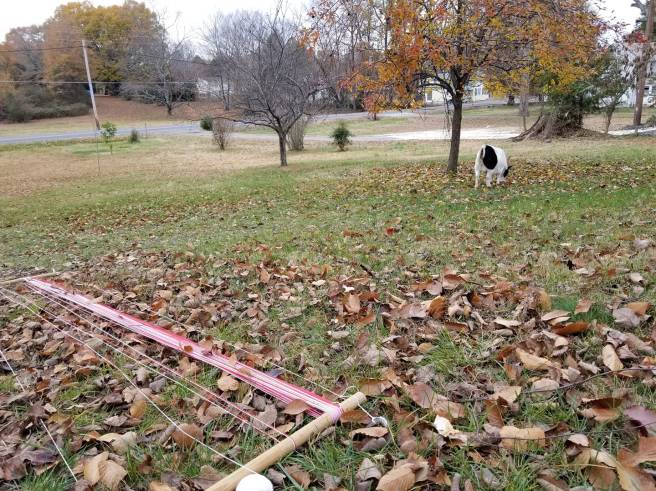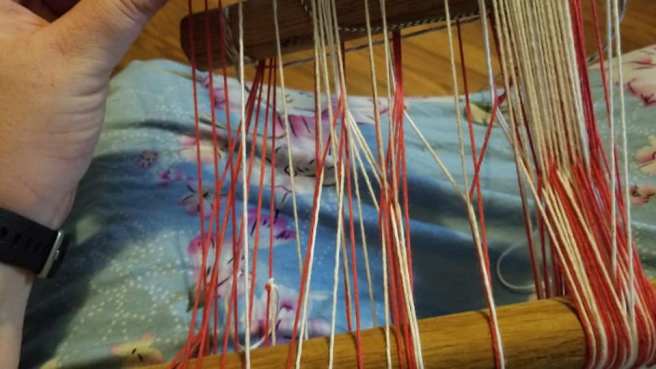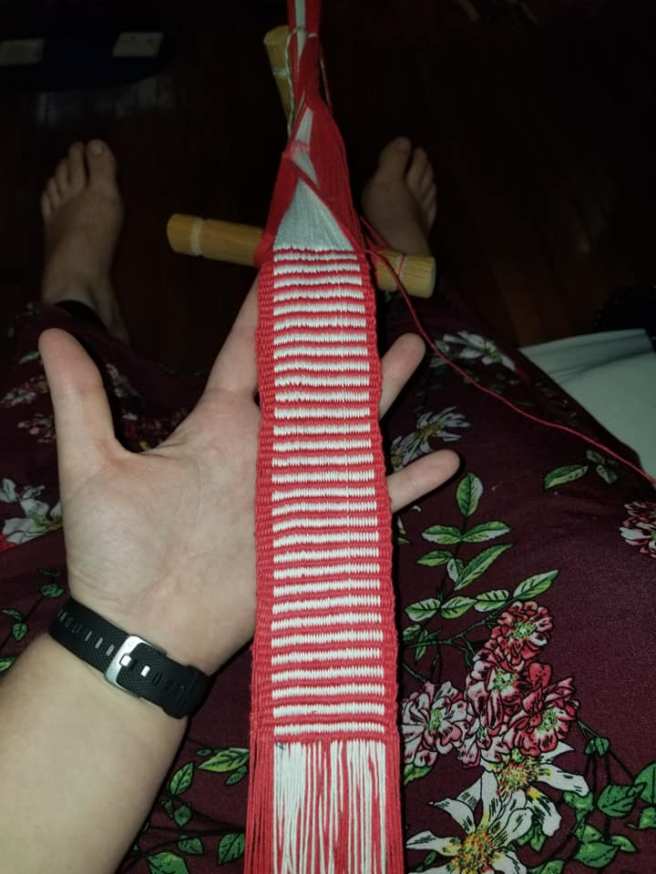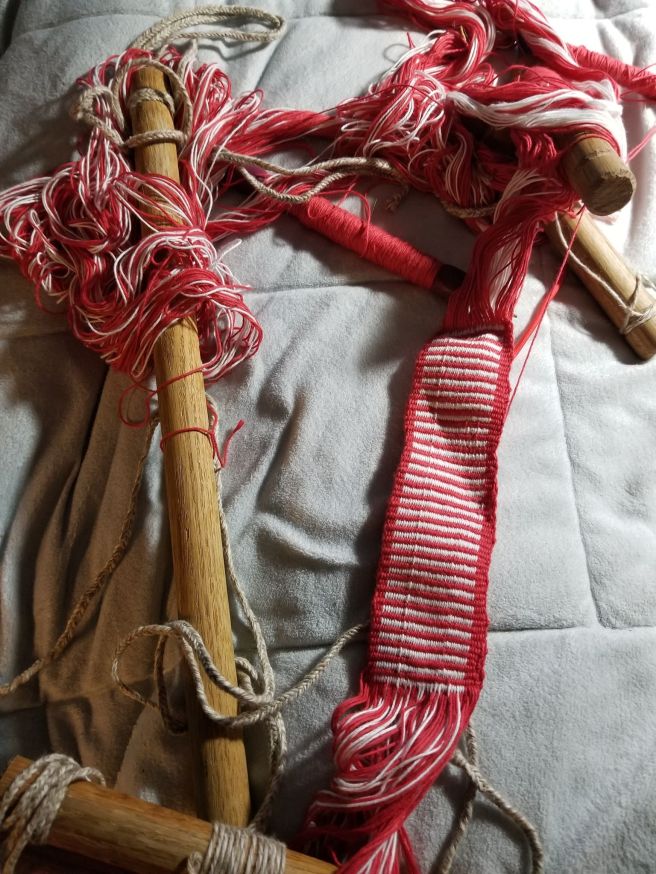This is a brief log of my early incomplete weaving projects and what I think went wrong.
The Giant Napkin for Grandma
For my second project, with the new flush of confidence and enthusiasm, I attempted to weave a four selvedged napkin, about 16″ by 16″. This project remains incomplete and likely will for some time.
I don’t seem to have any of the in progress photos for this piece, but I will add a couple of images when I dig out the loom it’s on.
What I Did
I wound the wide warp an a set of 4 pipe clamps with the loom bars tied to them. This was fairly successful and there aren’t major tension issues that I’ve noticed so far, but it was really hard to set up because I’m not allowed to use the nice tables, and the pipe clamps warp and bend the plastic portable tables. So it worked, but it had its own issues. The warp was wound continuously, the piece is striped shades of blue to blue gray to blue green, and it is intended to be warp faced.
In order for a piece to be four selvedged, it must not be left on the loom bars. I hand made cord for the warp selvedges (I don’t remember what method I used, they are either braided or whip cord braided), passed it through the warp ends, and lashed it to the loom. When I first did it, it even looked like it was going to work properly.
I spent 10 hours of my first ever Pennsic setting up the heddle for this piece. I will never, ever forget how to do a continuous string heddle after this experience.
However, this is where the piece still stands. It is all set up, but I can’t weave it.
Lessons
Some of my issues with this piece have to do with order of operation. If you attempt a plain weave four selvedged piece, I highly recommend you set up your heddles while still on the loom bars. There is more space and less confusion. This was an enormous, but not insurmountable, mistake.
The way I lashed the piece to the warp just plain didn’t work. I am not sure why. I tried to use more winds than what I have seen on museum pieces and modern Andean weaver’s looms to make it more stable for my first time, and it pulls away from the loom bar in places. I’m at a loss, but will attempt the pattern and/or string weight used on period looms or modern indigenous looms next time to see if this was a case of me trying to fix something that wasn’t broken.
I cannot open the sheds. Not even a little bit. People have suggested spray on conditioner, which I will try when I feel ready to deal with the cord lashing and have successfully completed a project more than 10 inches wide. I suspect I bit off more than I could chew.
The Extremely Long, Horizontal Striped Strap
This project was where I started for the very first piece of a bag I still intend to make. I am probably going to make a new strap, though.
This was intended to be about 1.5 inches wide and either 85 or 95 inches long. It has red edges and horizontally red and white stripes.
What I Did

I wound my warp on tent stakes with loom bars tied to them. This was an attempt to make an easier to remove version of the pegged loom I have seen indigenous women use to wind their warps. I will also admit this took place on an irregular slope and that there were a ton of leaves on the ground. I believe the length of the unwoven warp was about 108 inches.
This is the first time I warped in two, a concept explained in The Andean Science of Weaving by Denise Y. Arnold and Elvira Espejo, where you wind two colors at once. It worked as expected, and then I put the piece away for several months.

I heddled the piece in May or June after winding the warp in January. This was the first time I ever manipulated my sheds, which was exciting, but my warp was somewhat tangled (not nearly as bad as it could be, but still a mess). I managed it, and the loom worked when I was finished.

I successful wove about 10 inches, the stripes worked properly, but the band was wider than I intended.
Why It’s Unfinished
I took the partially completed piece down to show a group during a class and did not immediately re-roll the warp on the loom. It’s now the biggest mess and I don’t think I want to fix it. It would take many hours.
Lessons

This is the project where I found out that you can accidentally place two sheds or two heddles next to each other and leave the line artifact that I also have in my first project. It is absolutely correctable at the heddle stage, but I attempted to heddle this piece three times and only found the error two thirds of the way through the third time, and I was not willing to restart again. The piece still wove fine, and I learned how the artifact occurred.

Everything about how I warped up was an absolutely mess, and tent stakes are not a good substitute. This warp should have been wound by two people throwing the ball back and forth, like the indigenous women do in the Andes today. It was too long to do alone and maintain a consistent tension. The leaves were also a serious pain that the throwing method would have mostly avoided. The tension on the fully heddled warp was an absolute mess, but I could still make the loom work. There is no way this piece could have been properly 4 selvedged, it was too irregular at the ends.
I also learned how to properly do horizontal stripes. It looks sharp, the rest of the warp is just a disaster.

I will likely remake this piece and see if I can use the current warp piece by piece for other projects.

